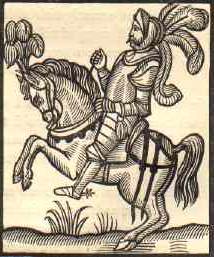Secular and religious ideals in conflict
From the beginning there was a tension in the chivalric ethic between the secular virtues of the warrior- knight and the religious ideals of Christianity. The Church encouraged a religious chivalry (culminating in the Crusades), which upheld an ethic of devotion to God, pious living, protection of the weak, and, of course, respect for the clergy*. The idea of the knight as a soldier of Christ gave rise to the medieval Orders of Chivalry, including England's Order of the Garter (whose emblem was, appropriately, Saint George and the dragon).
Holy wars
The Crusades embodied the religious theory of the "just" war in defense of the faith. However, opportunism soon superseded the religious goal of freeing the Holy Land from the Muslims ("Paynims"); the Fourth Crusade (1202-4) led to the sack of Constantinople and wars against the Greeks (for which the Pope nevertheless granted indulgences, even though the Greeks were also Christians).
Footnotes
-
Launcelot
In Malory's version of the Arthurian legend, Le Morte D'Arthur (published in 1485 by William Caxton), Launcelot (a chivalric archetype) even joins the clergy in his final days, dying as a monk. Malory's work was part of a chivalric revival in the 15th century, when social changes were lessening the importance of the knightly class and humanism offered a new set of secular values.
